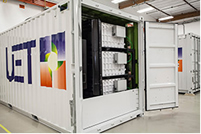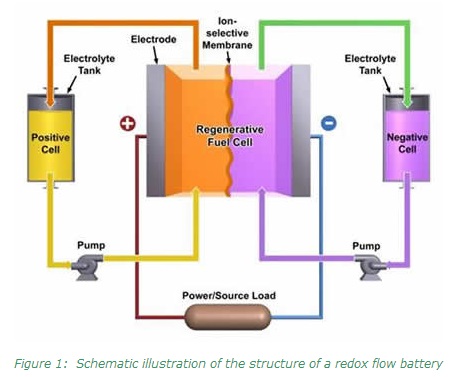UniEnergy Technologies (UET), manufacturer of large-scale energy storage systems for utility, commercial, and industrial, and microgrid applications, today announced commercial availability of the Uni.System grid-scale energy storage system.

The Uni.System is safe, operationally flexible, reliable, long-life, and economically compelling. Based in the Seattle area, UET operates a 67,000 sq ft engineering & manufacturing facility scaling up to produce 100 MW annually.
The system is modular, factory-integrated (including power conversion), and “plug & play,” comprised of five 20 ft standard containers requiring only a concrete pad and interconnection that provide 500 kWAC of power for four hours, with power up to 600 kWAC and energy up to 2.2 MWhAC.
“Utilizing a new generation of vanadium electrolyte initially developed at Pacific Northwest National Laboratory is a breakthrough product,” said UET President & CEO Gary Yang. He adds that it has double the energy density and a broader operating temperature range. “In addition to all the advantages of traditional vanadium redox flow batteries, such as superior safety, unlimited cycle life, long duration, and full use of the battery from 0 to 100% state of charge, the Uni.System is fully containerized including for the first time at grid-scale integrated electrolyte tanks, field-proven large-scale stacks, and optimized controls, and power electronics. The UET solution is rugged and versatile, built for enhanced reliability and minimized maintenance, with a flexible system design enabling multiple and concurrent power and energy applications delivering maximum value to customers.”
With the growing adoption of renewables such as wind and solar to meet portfolio standards and develop a clean energy future, the challenges of integrating these intermittent resources into the grid are escalating. Examples are solar in California, Hawaii, and Italy, and wind in the Pacific Northwest and Germany. The system is said to provide buffering capabilities – short and long duration – to integrate renewables effectively with the grid.
Energy storage is also critical to smart grids, similar to how data centers are key to the internet. The Uni.System provides a full range of power and energy function required to support the operation of a Smart Grid. That same “all-in-one” capability of the UET system, combined with its wide temperature tolerance (-40 to 50oC or -40 to 120°F), suits it to reliably supporting micro-grids in diverse locations and settings.
In addition, utilities must provide resiliency, such as after the impact of Sandy on New York and the eastern U.S. They face a complex business environment regardless of location. The developer says the Uni.System helps utilities meet its challenges: it is safe and reliable, its performance is third-party validated, and its upfront cost is affordable and its levelized cost of energy over the 20 year system life compelling.
UET
www.uetechnologies.com
Uni.System delivers 150 kW and 450 kWh energy per 20-ft container
The developer says benefits and specs of the Uni.System include:
- Engineered & built from the ground up for MW-class applications
- Designed for rapid deployment and dispatch flexibility
- Uses a single, cost-effective, adaptable product platform
- Produced with mature core components
- Applies UET’s breakthrough electrochemistry, originating from Pacific Northwest National Laboratory, with support from US DOE, Office of Electricity
- Standard string configuration of four 20’ battery containers and one 20’ inverter & transformer container, providing 600kW power; 1.8MWh energy
Safe
- Safe electrolyte – dilute, fire retardant acidic solution
- Thermally stable aqueous system with no risk of thermal runaway
- Built-in secondary containment with optical leak detection
- Automated detection, safe shutdown, bypass, and text notification of system status
- Full MSDS portfolio provided
- End-of-life disposal contracts included with all agreements
Field-rugged design
UET’s breakthrough electrolyte has been rigorously tested for several years and enables a unique set of compelling field characteristics:
- Cycle life agnostic exceeding 10,000 cycles
- SOC agnostic providing 100% capacity utilization over 20 years
- Charge agnostic from partial opportunity charging to extreme ripple currents
- Discharge agnostic with system flexibility from fractions of seconds, to 15 hours
- Temperature agnostic operation from -40°C to +50°C (-40°F to +122°F)
- Location agnostic from sea level to 10,000 feet (3km)
The Uni.System integrates the abuse tolerant UET electrolyte; a containerized design derived from multiple decades of design experience among the UET team; mature large-scale stacks with more than seven years of field deployment and over a dozen systems in the field; and state-of-the-art controls at each level of the at each system level (from cell to site).
High performance
The Uni.System offers a compelling solution set for multi-MW installations:
- One of the most powerful multi-hour energy storage products available
- Up to 23 MW/acre behind-the-fence deployed footprint
- Up to 46 MW/acre behind-the-fence deployed footprint (stacked configuration)
- Fastest response time
- 0.8 ms battery response time
- 50 ms total response time from full charge to full discharge power or reverse, limited only by communication and PCS control time
- Medium voltage 3-phase AC interface
- up to 34kV connection voltage
- 24/7 availability of 100% energy capacity
- no calendar life reduction with continuous cycling
- no active balancing requirements from a BMS
- no boost, taper, pulse or float
- Utility-class reliability
- redundant array architecture
- automated bypass of components requiring service
- 65-70% AC/AC efficiency
- 80% electrochemical efficiency
- high DC and AC voltages minimize I2R losses
- 97.5% AC/DC conversion efficiency
- passive cooling
Cost effective
While the components of the Uni.System are made entirely from commonly available commodity materials, it is also designed to be a cost-effective utility asset in the field from an operations and maintenance perspective:
- Durability
- 100% of energy capacity is available for cycling 24/7 with no calendar life reduction
- Long cycle life due to no solid-phase transitions
- Inert compatible materials used throughout the system
- Tier 1 material suppliers for membranes and electrodes
- Low system cell voltages avoid corrosion issues
- Tolerance to overcharge and overdischarge
- Low maintenance
- Design life of all components exceed 20 years
- Mature components with predictable maintenance
- No specialists or specialized tools required for maintenance
- Modular, swappable design
Filed Under: News, Software






Need external storage tnaks to help meet the 72 hour emergency generator requirement and then peak shedding and emerency generator service available???